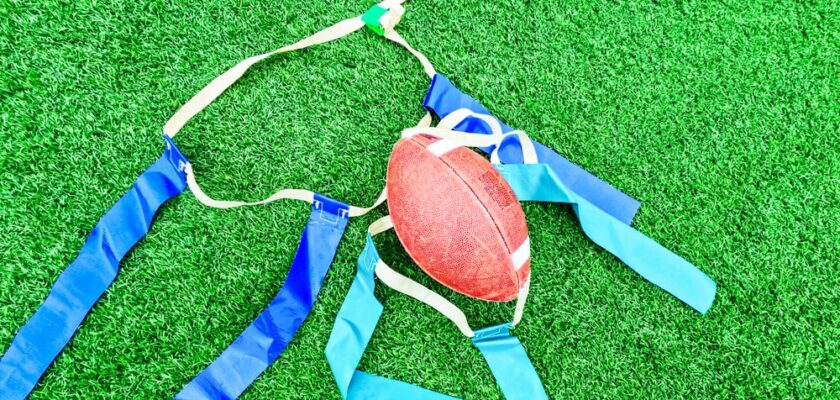Flag footbal is a sport that is a variation on American soccer, but with safer and more accessible characteristics for different age groups and skill levels.
Instead of knocking opponents to the ground, as in American soccer, players must remove a flag attached to their opponent’s waist to stop the play.
This version of the sport without heavy physical contact is what makes flag football a popular and safe choice in schools, communities and among families looking for a sport or competitive game.
Because it is similar to traditional American soccer, it is essential for fans to understand the rules of flag football. That’s why we’ve prepared this complete content for you!
Here, you’ll learn everything from the structure and dimensions of the pitch to the applicable penalties. Prepare your notes and get ready to learn the main rules of flag football!

Open your Betano account and get up to 1,000 reais in bonuses.
PIX payments, live games and super odds!
Click here to open your account!
Flag football rules: complete list
- Place of play;
- Duration of the game;
- Scoring;
- Players;
- Equipment;
- The game;
- Infractions and penalties;
- Referees;
- Security.
Flag football rules: playing venue
The flag soccer field has smaller dimensions compared to traditional American soccer, measuring 91 meters long by 30 meters wide. It is also divided into four 22-meter zones, with a 15-meter end zone at each end.
The end zone of the pitch is the area where points are scored, and is located after the goal line. The field markings include the sidelines, the midfield line and the goal lines, all of which are marked to make it easier for the players to see and interpret during the match.
Flag football rules: duration of the game
A flag football match is divided into two halves, each lasting between 20 and 25 minutes, depending on the rules of the league or tournament.
The clock runs continuously, stopping only in the final two minutes of each half for specific plays, such as time-outs, changes of possession or stops for fouls.
In the event of a draw, the game goes into extra time, when each team has an opportunity to score from a specific position on the pitch.
Flag football rules: scoring
In flag football, a touchdown, the main form of scoring, is worth 6 points. After a touchdown, the team has the option of attempting a 1-point conversion from the 5-yard line, or a 2-point conversion from the 10-yard line.
There are no field goal attempts, and the maximum score in a single play is 8 points (6 for the touchdown and 2 for the conversion). The sport is very similar to regular American soccer in this respect.
Flag football rules: players
A flag football team usually consists of 5 to 7 players on the pitch at any one time. The number can vary depending on the specific rules of the league. In addition to the players on the field, teams can have reserves, who can be substituted during breaks in play. Each team has a quarterback, who is responsible for starting plays, and other players who can be receivers or runners, as needed.
Flag football rules: equipment
The equipment needed to play flag soccer is minimal compared to traditional American soccer.
In the sport, each player must wear a belt with two or three flags attached by Velcro, which are easily removable. In addition, the use of shirts or vests that don’t interfere with the flags is mandatory so as not to harm the opponent!
Players also wear appropriate footwear, usually boots without metal studs, to avoid injuries. Helmets and shoulder pads are not used, as physical contact is minimized and not necessary.
Flag football rules: the game
Now let’s understand how a game of flag football works!
The match starts with a kickoff or, in some leagues, a throw-off, when the ball is thrown to the opponent from the middle of the field. After each point scored, the game is restarted in the same way. If the ball leaves the field or falls to the ground, possession is given to the opposing team at the spot where the ball left or fell.
Field advancement in flag football is done through a series of plays called downs. Each team has four downs to advance at least 10 yards.
If they succeed, they get a new series of four downs to continue advancing to the end zone. But if they fail to advance the 10 yards in four downs, possession is handed over to the opposing team.
The flags must be attached in such a way that they can be easily removed with a light pull. Removing a flag from the ball carrier ends the game immediately.
It is forbidden to hold, pull or push the opponent to try to remove the flag, as the sport does not have extreme physical contact. If the flag falls without interference, the game is stopped and the ball is considered dead at the point where the flag fell.
Flag football rules: infractions and penalties
Infractions and penalties are also common in flag football to maintain the order and safety of the game.
Among the most common infractions are flag guarding (which means protecting the flag with your hands), holding (holding the opponent), offside (starting the play before the play begins) and pass interference (interfering with the attempted reception of the pass).
Penalties vary in severity and can result in a loss of yards or additional downs for the opposing team.
Flag football rules: referees
Referees in flag football are responsible for monitoring play, signaling infractions, determining the placement of the ball and administering penalties.
In more formal competitions, there may be different types of referee with different responsibilities, such as line and field referees.
Flag football rules: safety
Even though flag soccer is a safer version of American soccer, the safety of the players remains the priority in the sport.
The rules of flag football are designed to minimize physical contact and prevent injuries, from the simplest to the most serious.
Any kind of physical blocking, tackling or use of excessive force is therefore prohibited. Leagues and tournaments often require players to take part in safety training and follow specific procedures to ensure a safe playing environment for all participants.

Flag football rules: complete list
- Place of play;
- Duration of the game;
- Scoring;
- Players;
- Equipment;
- The game;
- Infractions and penalties;
- Referees;
- Security.
Those were the rules of flag football! If you liked this content, keep following the site so you don’t miss any articles, lists, news and much more about the world of sports.



